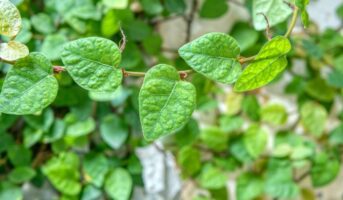What is Asystasia Gangetica?
Asystasia Gangetica, commonly known as Chinese violet, is a fast-growing perennial herb. It has simple, dark-green leaves, stems that root easily at the nodes, and cream-coloured flowers with semi-transparent purple markings on the lower petals of the corolla that bloom in the spring and summer, followed by an explosive green capsule.
This attractive, swiftly spreading, herbaceous plant has a height range of 12 to 20 inches. At the nodes, the stems quickly take root. Simple and dark green leaves are present. In the spring and summer, it produces a cream-coloured flower with purple tessellations on the palate (lower petal of the corolla).
Source: Pinterest
Asystasia Gangetica: Facts
| Common Name | Chinese violet |
| Height | 12 to 20 inches |
| Flower | Purple and white colour |
| Light | Partial sun |
| Origin | Indian subcontinent |
| Scientific name | Asystasia gangetica |
| Family | Acanthaceae |
Types of Asystasia Gangetica
Asystasia Intrusa
Asystasia Parvula
Asystasia Querimbensis
Asystasia Pubescens
Asystasia Subhastata
Asystasia Quarterna
Asystasia Scabrida
Asystasia Floribunda
Asystasia Coromandeliana
Justicia Gangetica
Asystasia Bojeriana
Asystasia Acuminata
Asystasia Coromandeliana
Asystasia Multiflora
Asystasia Ansellioides
Asystasia Podostachys
Asystasia Gangetica: Growing tips
- Flowering occurs from late spring to late summer.
- When planting Asystasia, keep in mind that it can spread quickly and may not stay in the desired area! It thrives in either full sun or partial shade and can be planted in most free-draining acidic to neutral soils.
- Once herbaceous perennial varieties have formed established clumps after three years, they should be divided to maintain vigour. Many perennial herb plants can be divided in late fall, but spring may be a better time because they are just starting to grow. If a cold, wet winter follows, the autumn division may lead to the loss of smaller divisions. The most basic method is to cautiously dig around the clump and simply pull it apart into fist-sized pieces before replanting. The centre of the initial clump should be removed because it has lost vigour and has become woody.
How to care for Asystasia Gangetica?
Sun or shade
Asystasia gangetica prefers shade, and full sunshine between 30% and 50% is ideal for photosynthesis. Under an enclosed canopy of oil palms receiving less than 10% of its total daily light, it grows, albeit slowly.
Soil
It may be planted in any type of garden soil, but it will grow more successfully if a lot of compost is added. Propagate by removing rooted runners or cuttings made after the plant has flowered (small plants must be protected from frost).
Please be aware that Asystasia gangetica should only be planted cautiously as it can become quite invasive. Because of its capacity to spread vegetatively, it may suffocate nearby vegetation with its herbaceous layer.
Pruning
Pruning is necessary to control the vigorous growth of this plant.
Source: Pinterest
What are the benefits of Asystasia Gangetica?
- Locals use Asystasia gangetica as a leafy vegetable and herb, primarily during times of scarcity. It is a common vegetable in Kenya and Uganda when combined with beans, peanuts, or sesame paste. It is frequently served with other green vegetables in a mixture.
- Asystasia gangetica is occasionally recommended as a cover plant in orchards because it reduces erosion, guards against noxious weed infestation, and draws bees to the orchard. In South-East Asia, Asystasia gangetica is used as a pasture for cattle, goats, and sheep; it is either grazed or cut for stall feeding because of its capacity to grow in shadow and its high nutritional content. Sheep who consume too much risk bloating.
- In Africa, the plant’s infusion is used to cure childbirth pain, and the sap is applied to sores, wounds, and piles. Roots that have been powdered are used to cure snakebites and stomach aches. A leaf decoction is used to treat epilepsy, urethral discharge, and as an analgesic. The leaves are used to cure asthma in Nigeria.
- The sap is applied to swellings in India and is also used to cure rheumatism and as a vermifuge.
- In the Moluccas (Indonesia), the juice is suggested for dry coughs accompanied by an itchy throat and discomfort in the chest, together with lime and onion juice.
FAQs
What are the diseases and pests associated with Asystasia gangetica?
The fungus Colletotrichum dematium, which results in necrosis, defoliation, and stunted growth in Asystasia gangetica, is capable of infecting it. It has been noted that it serves as a host plant in West Africa for a mottle virus that is spread by aphids.
Is it Asystasia gangetica perennial?
Yes, it is a perennial plant.
Housing News Desk is the news desk of leading online real estate portal, Housing.com. Housing News Desk focuses on a variety of topics such as real estate laws, taxes, current news, property trends, home loans, rentals, décor, green homes, home improvement, etc. The main objective of the news desk, is to cover the real estate sector from the perspective of providing information that is useful to the end-user.
Facebook: https://www.facebook.com/housing.com/
Twitter: https://twitter.com/Housing
Email: editor@housing.com

